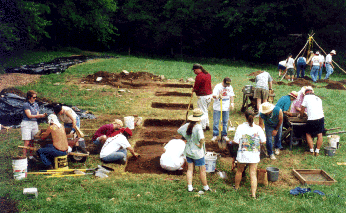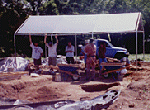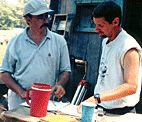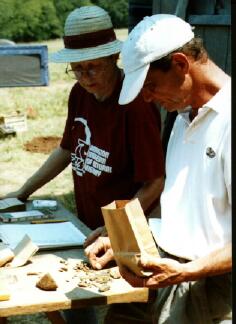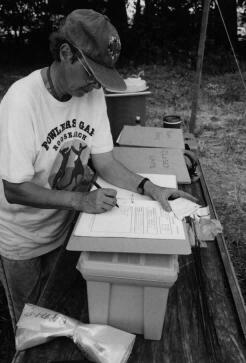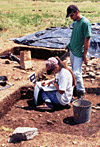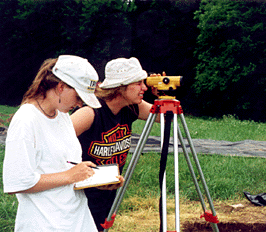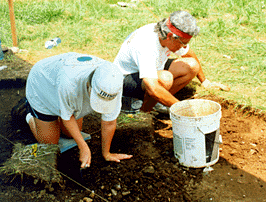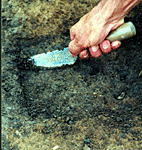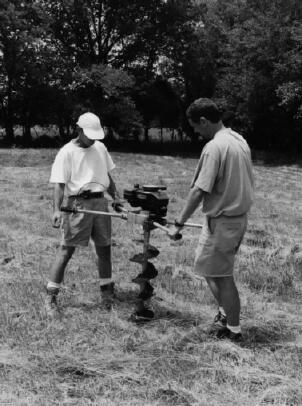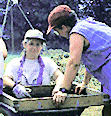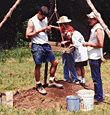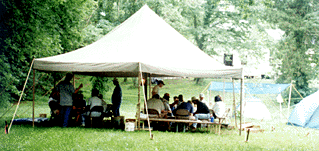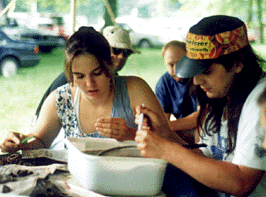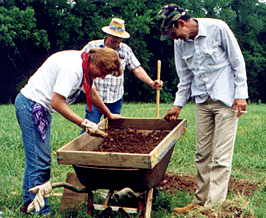Bledsoe's Lick Archaeological Project Education
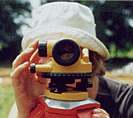
|
Each project sponsored under the auspices of the Bledsoe's Lick Archaeological Project includes a significant focus on educating students and the public about archaeology. For students, ANTH 4950/5950 Archaeological Field School provides an intensive, but rewarding hands-on experience in "what archaeologists do." While these topics can be covered "in theory" in the classroom, the only way to truly appreciate the rigorous methods and techniques of field archaeology is through experiential learning.
During the course, students experience first-hand the methods and techniques of field archaeology -- and the necessary skills to work together as a team. Setting up each morning requires more than two hands!
The public nature of the project also requires that students develop and practice oral presentation skills -- explaining what they are doing (and why) to site visitors. Patience is another skill tested to the limit as we answer (over and over and over again) those important questions such as "Watcha finding?"; "Found any gold yet?" and "How deep will you go?"
At the heart of all archaeological field techniques is the systematic and meticulous recording of information. Unlike many experimental sciences, archaeologists do not have a "second chance" -- archaeology destroys what it uncovers. Working in small crews, each student learns how to locate, lay out, and excavate units on a site grid -- the most important difference between simply "collecting artifacts" and "doing archaeology" is the rigorous attention to recording where artifacts came from in three dimensions.
Students practice the skills of labeling bags for artifacts, completing forms for each excavated unit and level, measuring width, length and depth systematically, and drafting planviews and profiles of excavations and features. To borrow a phrase, there are three keys to a successful field project: (1) Paperwork, (2) paperwork, and (3) more paperwork.
The use of surveying equipment to record the location and depth of artifacts, features, and other important "stuff" at the dig site is a basic skill taught in the field. While many students are intimidated by the equipment at first, they quickly discover that most of the skills needed involve more "common sense" than they do rocket science.
In addition to the recording skills, students are required to learn the skills of the archaeologist in careful excavation. Project personnel have used a variety of tools and techniques over the years of the project -- ranging from trowels to shovels and gasoline-powered augers to backhoes. While shovels and picks are common tools on the archaeological site, the true skill of the trained archaeologist is to know "when to switch to the trowel and brush." The goal of archaeology is not to move a lot of dirt around -- the goal is to recover the maximum amount of information using the most appropriate techniques.
In addition to excavation techniques, a variety of artifact recovery methods are practiced as a matter of course. Screening using ¼ inch hardware mesh is a base component of artifact recovery. Screens come is a variety of designs and some exposure to a variety of these types is part and parcel of each field project. Some sit directly atop wheelbarrows next to the excavation units, providing a simple and readily portable tool (but a strain on the back after a few hours!). These are particularly efficient when excavating small test units scattered over a larger area.
Others include still portable but more permanent stands for the screens -- with room to roll a wheelbarrow underneath - less strain on the back!.
The most popular are tripod-supported screens. These permit more rapid processing by rocking the screens back and forth -- and keep the rapidly growing "backdirt" piles centralized during large scale excavations in a single area. The importance of keeping your dirtpiles away from a major excavation can only be appreciated by those who have found that the foundation wall of their house leads inexorably beneath the backdirt pile... Few tasks are more onerous than hauling all of that nicely screened backdirt to a new location so that excavations can continue!
Students also have a chance to participate in the preliminary stages of labwork and analysis in the field. Even when inclement weather prohibits excavation, students continue work washing artifacts as they collect them. While primitive, the field lab provides an opportunity for students to learn what artifacts do and don't look like. The transformation of "some kind of thing in a glob of dirt" into a gunflint, a decorated piece of ceramic, or even a bit or rock to throw away is the key to learning why archaeologists throw all those dirt globs in the bag.
In reality, field archaeology can be tedious and repetitious. Unlike the movies, where only those few moments of "great discoveries" are glamorized and publicized, fieldwork in the Tennessee summer is often hot, sweaty, bug ridden, and tiresome. Nonetheless, when those few moments of "great discovery" do come -- after days or weeks or months of hard labor -- they are worth the effort to many.
As succintly expressed by some past participants in the field school (Bicentennial Birthplace, Suma Clark, MTSU Magazine, Spring/Summer 1996):
- Kevin Osman: "Sometimes when you found certain things, personal things, as you were digging in a cellar, you had the feeling that they were almost the way they would have been when people lived there."
- Andy Goldthwaite: "I had a really good time in spite of the heat, the bugs, the shoveling. I never once woke up thinking 'I don't want to do this!' I think everyone felt the same way."
- Phillip Hodge: "there was a big sense of being involved in the results of the labor; it was much more than just a grade."
Volunteers
In addition to the formal field course, the Bledsoe's Lick Archaeological Project welcomes involvement by interested members of the public in "rediscovering" the early history of Tennessee. While the workweek is devoted to training students, "Volunteer Dig Days" scheduled on Saturdays have allowed many interested members of the community to get involved. Supervised by students, these volunteers are the most valuable part of making archaeological research meaningful to the interested public.
In years past, an average of twenty volunteers have participated in the project on each Saturday "Volunteer Day" -- some returning year after year. Because of the rigorous requirements for detailed supervision, recording and paperwork, the number of volunteers that can be accepted for each volunteer day is limited. Over the past several years, over 300 volunteers ranging in age from 7 to 70 have worked on excavating, screening for artifacts, and assisting in preliminary labwork on site.
